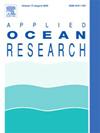Experimental study on shock wave and bubble pulsation behavior generated by underwater aluminum wire electrical explosion
IF 4.3
2区 工程技术
Q1 ENGINEERING, OCEAN
引用次数: 0
Abstract
Underwater electrical wire explosion (UEWE) is an efficient source of underwater shock waves and bubble pulsation. However, the impact of wire parameters on the dynamics of shock waves and bubbles generated by UEWE has not been thoroughly explored. In this paper, we present novel insights based on a self-built UEWE experimental platform, where high-power electric pulses are used to ionize and explode aluminum wires of varying diameters and lengths in water. The experimental investigation focused on the resulting shock waves and bubble pulsation behavior, contributing to a deeper understanding of the mechanisms underlying these phenomena. First, we examined the energy storage conditions of the pulse capacitor and characterized the discharge behavior of the electrical explosion. Subsequently, we analyzed the bubble generation mechanism and the complete pulsation process, comparing the maximum bubble radius with the Rayleigh-Plesset equation solution, finding a high degree of consistency during the first pulsation period. Furthermore, we explored the relationships between the maximum bubble radius, shock wave energy, bubble energy, shock wave pressure, pulsation pressure curves, and bubble pulsation period under various experimental conditions. Our results demonstrate that for a 0.5 mm diameter aluminum wire, both the shock wave energy and bubble energy are positively correlated with the wire length, achieving maximum efficiencies of 13.04 % and 79.7 %, respectively. The shock wave peak under each experimental condition also shows a positive correlation with wire diameter and length, while the second pressure wave exhibits a concave trend and the third a convex trend. Notably, before the bubble pulsation period reaches its peak, the period shortens as the wire diameter and length increase, influenced by the aluminum-water reaction. These findings provide a novel perspective on UEWE, advancing the research of explosion bubbles to ensure safer and more efficient underwater explosions, thereby contributing to the broader field of underwater explosion mechanics.
求助全文
约1分钟内获得全文
求助全文
来源期刊

Applied Ocean Research
地学-工程:大洋
CiteScore
8.70
自引率
7.00%
发文量
316
审稿时长
59 days
期刊介绍:
The aim of Applied Ocean Research is to encourage the submission of papers that advance the state of knowledge in a range of topics relevant to ocean engineering.
 求助内容:
求助内容: 应助结果提醒方式:
应助结果提醒方式:


